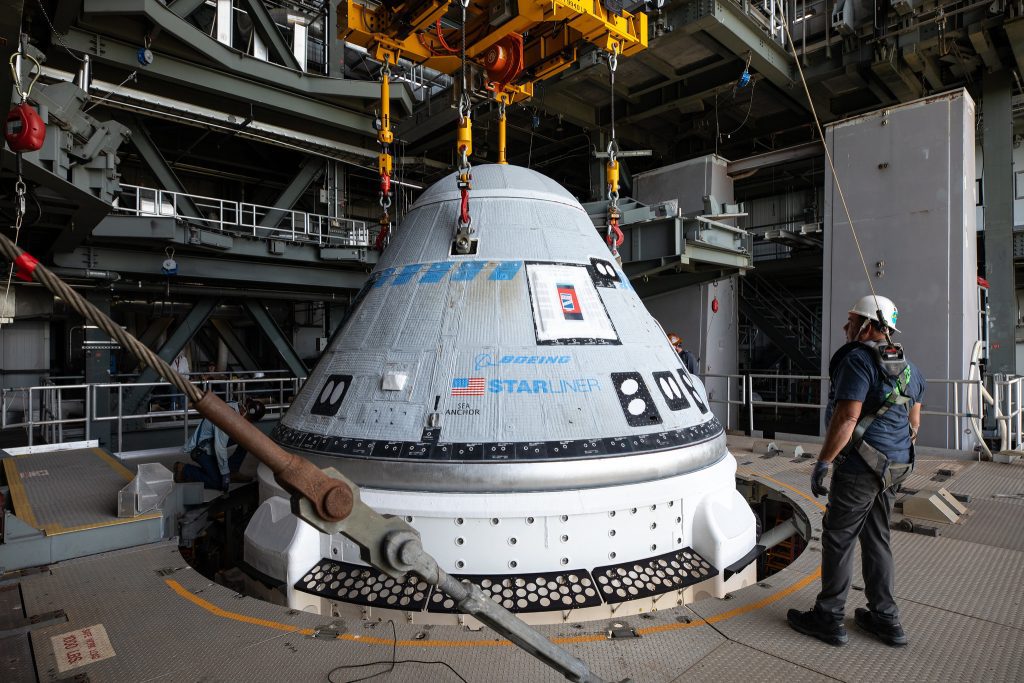WASHINGTON — The first crewed flight of Boeing’s CST-100 Starliner spacecraft has moved closer to being launched after successfully finishing a significant pre-launch review on April 25.
NASA declared at a briefing on April 25 that, following the two-day Flight Test Readiness Review, officials have given the green light to proceed with the Crew Flight Test (CFT) mission. The launch is set for 10:34 p.m. Eastern on May 6 from Cape Canaveral’s Space Launch Complex (SLC) 41. Alternative launch opportunities are available on May 7, 10, and 11.
“I can say with confidence that the teams have absolutely done their due diligence,” said NASA Associate Administrator Jim Free. “There’s still a little bit of closeout work to do, but we are on track for a launch.”
The remaining tasks involve what Steve Stich, NASA commercial crew program manager, referred to as “a couple standard things” for pre-launch preparations. This includes replacing a valve in a liquid oxygen replenishment system at SLC-41 and conducting additional analysis on a part of the parachute system that releases a cover known as the forward heat shield, enabling the drogue and main parachutes to deploy. This extra analysis is being done “out of an abundance of caution,” he added.
The launch also depends on the readiness of the International Space Station. A cargo Dragon spacecraft, CRS-30, must undock from the station, after which the four members of the Crew-8 crew will board their Crew Dragon spacecraft and move it from the forward to the zenith port on the Harmony module. This will free up the forward port for Starliner, which currently only has approval to dock to that port.
The CRS-30 Dragon spacecraft was supposed to undock from the ISS on April 26, but its departure has been delayed to at least April 28 due to weather at splashdown locations. Dana Weigel, NASA ISS program manager, stated that it was too early to determine how much further the CRS-30 departure could be delayed without causing a postponement of the Starliner launch, but suggested that the Starliner launch could proceed as planned as long as the Crew Dragon port relocation occurs by May 2 or 3.
The CFT mission aims to assess spacecraft systems with astronauts on board following two previous uncrewed flights, the second of which took place almost two years ago. Boeing had originally planned to carry out the CFT last year but had to postpone the mission. due to issues with parachute system components as well as removing flammable tape used in wiring systems.
NASA astronauts Butch Wilmore and Suni Williams will pilot the Starliner, docking with the ISS about a day after launch. They will remain on the station for more than a week before undocking to return to Earth, landing in the southwestern United States. They will carry out a series of test objectives, including confirming the performance of the spacecraft's life support system and conducting manual control flight.
Mark Nappi, vice president and program manager for Boeing’s commercial crew program, sidestepped questions at the briefing about the long-term future of Starliner, which presently only has a contract with NASA to launch six post-certification, or operational, missions to the ISS after the CFT mission. “The focus again is on CFT. That really has all of our attention at this point,” he said.
The NASA agreement carries Boeing until the end of the decade and the projected retirement of the ISS, assuming one flight a year. There's plenty of time to think about what comes next, but right now the focus is on CFT.
He also felt no pressure to “score a win” with the test flight given the issues facing Boeing’s commercial airplane unit. “We committed to do this and we will be successful at it,” he said. “I think of it as important for this program, to follow through with the commitments we made to our customers.”
At an April 17 meeting of NASA’s Aerospace Safety Advisory Panel, Susan Helms, a former astronaut and current panel chair, said her committee was confident that safety was a top priority for those involved in the mission.
“The panel believes that NASA has an appropriate, mature risk management framework in place to address the challenges of this Crew Flight Test of the Starliner, and that NASA’s safety culture seems strong and up to the task,” she said, while adding that NASA and Boeing needed to be prepared for any unexpected situations during the test flight.
This also applies to the astronauts flying on Starliner. “Why do we think it’s as safe as possible?” Wilmore said to reporters after he and Williams arrived at the Kennedy Space Center April 25. “We wouldn’t be standing here if we didn’t.”









